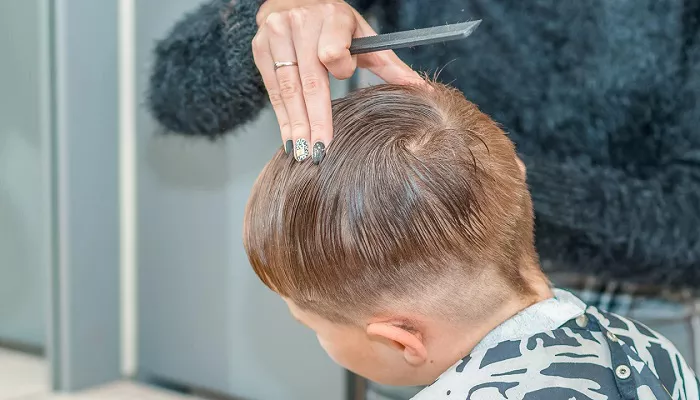The decision of whether or not to cut a child’s hair is one that many parents grapple with. It involves considerations ranging from practicality to cultural and personal preferences. In this article, we will explore the various aspects that come into play when making this decision.
Practical Reasons for Cutting Children’s Hair
Ease of Maintenance
One of the primary practical reasons for cutting a child’s hair is ease of maintenance. Long hair can be challenging to manage, especially for young children who may not be able to take care of it themselves. Short hair is often quicker to wash and dry. For example, a short bob or a pixie cut can be rinsed and dried in a matter of minutes compared to long, flowing locks that may take a significant amount of time to wash thoroughly and dry properly. This can be a great advantage during busy mornings when getting the child ready for school or other activities.
Hygiene
Shorter hair can also contribute to better hygiene. Long hair has a greater surface area and can trap more dirt, dust, and sweat. This can lead to an unpleasant smell and may even cause skin issues such as scalp irritation if not cleaned regularly.
With short hair, it is easier to keep the scalp clean, reducing the risk of such problems. Additionally, children with short hair are less likely to get food or other debris caught in their hair during mealtime.
Active Lifestyles
Children are usually very active, constantly running, jumping, and playing. Long hair can get in the way during these activities. It may fall into the child’s face, obscuring vision and causing distractions. For sports – loving kids, short hair can be a boon. It won’t interfere with their movements, whether they’re playing soccer, climbing on the playground, or engaging in other physical pursuits.
A short cut like a crew cut for boys or a short bob with a headband for girls can keep the hair out of the way and allow the child to move freely.
Cultural and Social Considerations
Cultural Significance
In many cultures, hair holds great symbolic value. For some, cutting a child’s hair may be a rite of passage or have specific religious meanings. In certain Native American tribes, for instance, a child’s first haircut is a significant event, often accompanied by ceremonies. In contrast, some cultures may view long hair as a symbol of beauty or femininity and may be reluctant to cut a girl’s hair until a certain age. Understanding these cultural connotations is essential when deciding whether to cut a child’s hair, as it can impact the child’s identity within their community.
Social Norms and Peer Influence
Social norms also play a role. In some schools or social groups, there may be an unspoken preference for certain hairstyles.
Parents may feel pressure to conform to these norms to help their child fit in. However, it’s important to balance this with the child’s own individuality. For example, if all the boys in a class have short hair, a parent may consider cutting their son’s hair to avoid him standing out. On the other hand, allowing the child to have a unique hairstyle can also boost their confidence and sense of self.
Emotional and Psychological Aspects
The Child’s Preference
As children grow older, they often develop their own opinions about their appearance. It’s crucial to consider the child’s preference when thinking about cutting their hair. Some children may love their long hair and be very attached to it, while others may want a change. Having a conversation with the child about how they feel can make a big difference. If a child is forced to have their hair cut against their will, it can lead to feelings of sadness, anger, or a sense of loss.
Self – Image and Confidence
Hair can have a significant impact on a child’s self – image and confidence. A new haircut can either boost or undermine their self – esteem. A well – chosen cut that the child likes can make them feel more confident and stylish. For example, a child who gets a trendy haircut that they’re excited about may walk with more pride. However, a haircut that the child dislikes can have the opposite effect. It’s important to choose a style that complements the child’s face shape and personality to enhance their self – image.
Health and Hair Quality
Hair Growth and Thinning
Cutting a child’s hair can sometimes be beneficial for hair growth. Trimming the ends regularly can prevent split ends, which can travel up the hair shaft and cause breakage. This allows the hair to grow healthier and stronger. In some cases, if a child has very thick hair that seems to be thinning at the roots due to the weight of the long hair, a cut can relieve this stress and promote better hair growth.
Scalp Health
A proper haircut can also improve scalp health. If the hair is cut in a way that allows for better air circulation to the scalp, it can reduce the risk of scalp conditions such as dandruff or fungal infections. For example, a shorter cut with layers can provide more ventilation to the scalp compared to long, heavy hair that lies flat.
Conclusion
In conclusion, the decision to cut a child’s hair is a complex one that involves multiple factors. From the practical aspects of ease of maintenance and hygiene to cultural, emotional, and health considerations, parents need to weigh all these elements carefully. By taking into account the child’s lifestyle, cultural background, personal preference, and the potential impact on their self – image and hair health, parents can make an informed decision that is best for their child. Whether it’s a simple trim or a more drastic cut, the goal should be to ensure that the child is comfortable and happy with their new look.

